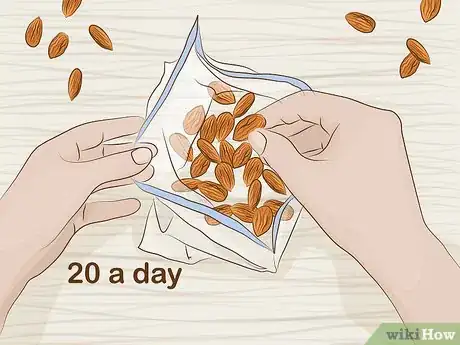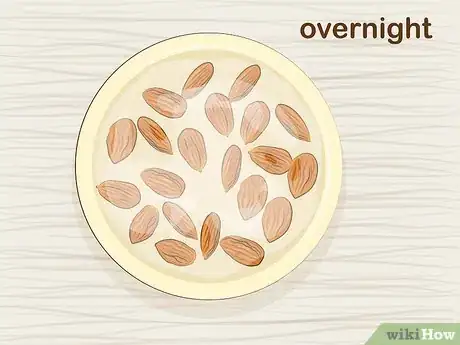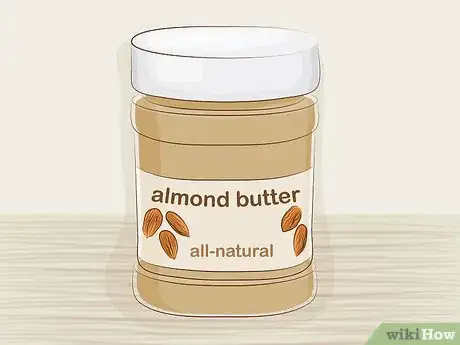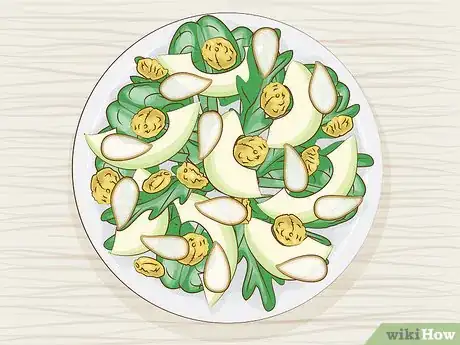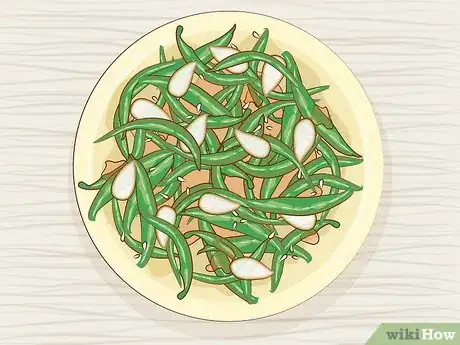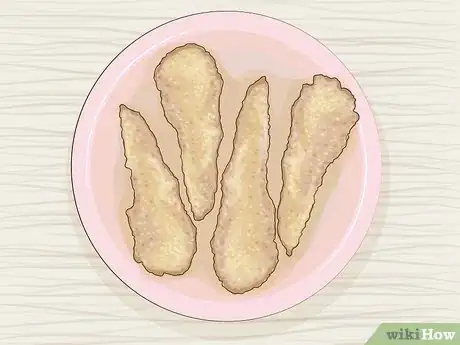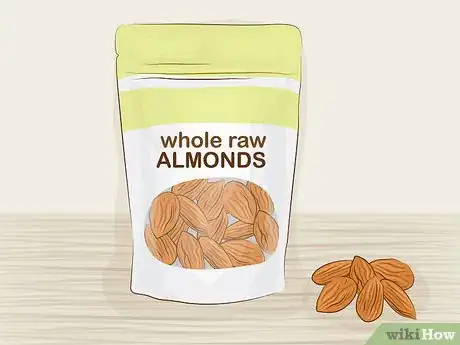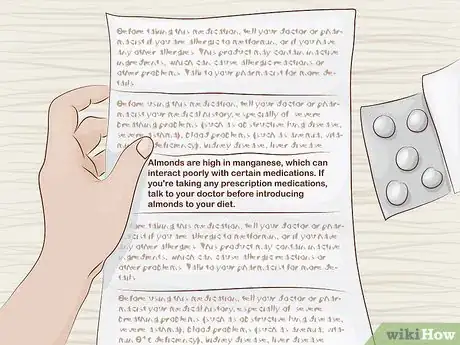This article was co-authored by wikiHow Staff. Our trained team of editors and researchers validate articles for accuracy and comprehensiveness. wikiHow's Content Management Team carefully monitors the work from our editorial staff to ensure that each article is backed by trusted research and meets our high quality standards.
This article has been viewed 62,434 times.
Learn more...
Almonds are an easy, nutrient dense snack that are a rich source of vitamin E and antioxidants. You can enjoy almonds as a snack between meals. You can also add them to other foods. Make sure you choose healthy raw almonds and watch your overall intake. While almonds are healthy, they are high in calories. Overindulging can lead to weight gain.
Steps
Snacking on Almonds
-
1Limit your almond intake to about 20 almonds a day. Almonds are high in calories, so it's recommended you limit your intake to three to four ounces a day. This roughly comes out to around 20 to 23 almonds.[1]
- You can measure out about 20 almonds and place them in a plastic bag. You can also pick 100-calorie packs of almonds at a local supermarket.
-
2Try soaked almonds. Some people prefer soaking their almonds, as this activates some enzymes in the almonds that may make them easier to digest. Place your almonds in a bowl and soak them in water overnight. In the morning, remove them from the water and rinse them. Then, place them on a wet towel for an additional 12 hours.[2]
- Keep in mind, there is no hard evidence that almonds are inherently more nutritious when soaked. You can still get nutrients from un-soaked almonds.
Advertisement -
3Experiment with flavored almonds. If you want a little extra flavor, purchase flavored almonds in the store. Almonds are often salted, roasted with honey, or coated in spices like cinnamon and cocoa.[3]
- Make sure to read ingredients labels before purchasing flavored almonds, however. Avoid flavored almonds that are very high in sugar or calories. A high sugar content can take away from the overall health benefits of almonds.
-
4Add almonds to trail mix. Trail mix can make a healthy snack when it's made from ingredients like dried fruit and nuts. You can buy trail mix with almonds mixed in or add your own almonds to trail mix.[4]
- Get trail mix without any added sugar. Dried fruit can sometimes have a lot of sugar added unnecessarily.
- Some trail mixes come with added chocolate. Dark chocolate is the healthiest option, so opt for mixes with dark chocolate.
Adding Almonds to Other Foods
-
1Try using quality almond butter. Almond butter can be a great addition to toast and bread. It can also be used as a dip for veggies and fruits. Look for an all-natural almond butter without added sugar. Almond butter is usually found in the same section as peanut butter at grocery stores.[5]
- Make sure to track how much almond butter you're eating. While it can be healthy, it is high in calories.
-
2Add sliced almonds to a salad. You can buy bags of sliced almonds at most supermarkets. These can easily be sprinkled over salads to add a little flavor and crunch. If you're only eating a salad for lunch, adding almonds can make the meal a lot more filling.
- Make sure you account for sliced almonds in your overall almond intake for the day. Remember, you should only eat around 20 almonds a day.
-
3Cook almonds with healthy green vegetables. If you'e sautéing something like green beans or asparagus for dinner, toss some sliced almonds onto the skillet. Cooking almonds with green vegetables adds protein to a side dish, making it more filling. It can also add a pleasant, crunchy texture.
- For added health benefits, cook your almonds and veggies in heart-healthy olive oil instead of butter.
-
4Coat chicken with ground almonds. Instead of using flour as a coating for fried or grilled chicken, use ground almonds. Place a handful of almonds in a food processor and grind them until they're a fine, sand-like texture. Coat the chicken in the almond mixture before throwing it on the skillet.
- You can also buy almond flour at the grocery store to cook your chicken.
-
5Add almonds to a smoothie. If you make smoothies between meals or as a meal replacement, almonds can be an excellent addition. Toss a small handful of almonds into the blender when making your smoothie. This can add some flavor and boost the amount of protein in your smoothie, making it more filling.[6]
- While some people add almond milk to smoothies, this does not have a very high content of actual almonds. You're better off using whole milk or soy milk alongside real almonds.
Keeping Nutrition in Mind
-
1Go for whole, raw almonds. The best types of almonds are raw almonds without added sugar, salt, or spices. You can usually find raw almonds at the supermarket alongside other nuts and snacks.[7]
- If you decide you want to flavor your almonds, you can always lightly salt them or add spices like cinnamon at home.
-
2Avoid almonds if you have problems with your kidneys or gallbladders. Almonds are not safe for everyone. They have high levels of oxalates, which can affect the kidneys and gallbladder. If you have health issues involving these organs, it's best to avoid eating almonds.[8]
-
3Make sure almonds don't interact with your medication. Almonds are high in manganese, which can interact poorly with certain medications. If you're taking any prescription medications, talk to your doctor before introducing almonds to your diet. You should make sure almonds will not interact poorly with any prescribed medications.[9]
References
- ↑ https://fitnesspell.com/how-many-almonds-should-you-eat-in-a-day-is-good-for-health-and-its-side-effects/
- ↑ http://www.naturallifeenergy.com/should-i-soak-almonds-benefits-of-soaking-almonds/
- ↑ http://www.fitday.com/fitness-articles/nutrition/healthy-eating/5-healthy-almond-snacks.html
- ↑ http://www.fitday.com/fitness-articles/nutrition/healthy-eating/5-healthy-almond-snacks.html
- ↑ https://www.healthaliciousness.com/super-foods/almonds.php
- ↑ http://www.muscleandfitness.com/nutrition/healthy-recipes/5-ways-eat-almonds
- ↑ https://www.healthaliciousness.com/super-foods/almonds.php
- ↑ https://fitnesspell.com/how-many-almonds-should-you-eat-in-a-day-is-good-for-health-and-its-side-effects/
- ↑ https://fitnesspell.com/how-many-almonds-should-you-eat-in-a-day-is-good-for-health-and-its-side-effects/
About This Article
Almonds make a great nutritious snack or addition to many meals. Just keep in mind that almonds are high in calories, so you shouldn’t eat more than 20 a day if you're not trying to gain weight. For a snack, try eating almonds by themselves or add them to trail mix. You can also buy flavored almonds or salted almonds if you find them too bland on their own. For breakfast, try adding almonds to a smoothie for a protein boost. You could also eat almond butter on toast. Additionally, almonds make a great addition to salads or sautéed vegetables. To learn when you should avoid eating almonds, read on.
